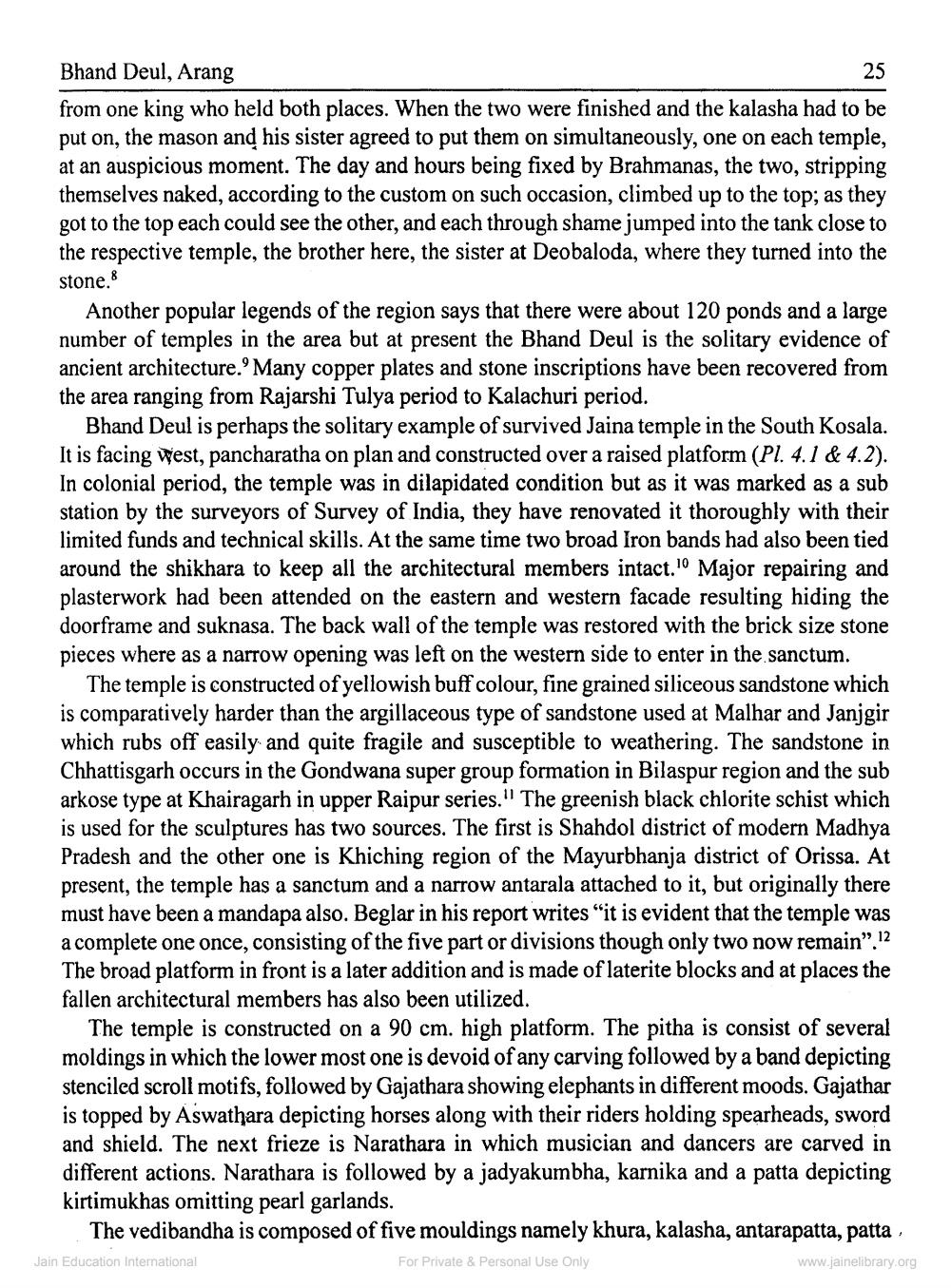________________
Bhand Deul, Arang
25
from one king who held both places. When the two were finished and the kalasha had to be put on, the mason and his sister agreed to put them on simultaneously, one on each temple, at an auspicious moment. The day and hours being fixed by Brahmanas, the two, stripping themselves naked, according to the custom on such occasion, climbed up to the top; as they got to the top each could see the other, and each through shame jumped into the tank close to the respective temple, the brother here, the sister at Deobaloda, where they turned into the stone.8
Another popular legends of the region says that there were about 120 ponds and a large number of temples in the area but at present the Bhand Deul is the solitary evidence of ancient architecture.' Many copper plates and stone inscriptions have been recovered from the area ranging from Rajarshi Tulya period to Kalachuri period.
Bhand Deul is perhaps the solitary example of survived Jaina temple in the South Kosala. It is facing west, pancharatha on plan and constructed over a raised platform (Pl. 4.1 & 4.2). In colonial period, the temple was in dilapidated condition but as it was marked as a sub station by the surveyors of Survey of India, they have renovated it thoroughly with their limited funds and technical skills. At the same time two broad Iron bands had also been tied 10 around the shikhara to keep all the architectural members intact. Major repairing and plasterwork had been attended on the eastern and western facade resulting hiding the doorframe and suknasa. The back wall of the temple was restored with the brick size stone pieces where as a narrow opening was left on the western side to enter in the sanctum.
The temple is constructed of yellowish buff colour, fine grained siliceous sandstone which is comparatively harder than the argillaceous type of sandstone used at Malhar and Janjgir which rubs off easily and quite fragile and susceptible to weathering. The sandstone in Chhattisgarh occurs in the Gondwana super group formation in Bilaspur region and the sub arkose type at Khairagarh in upper Raipur series." The greenish black chlorite schist which is used for the sculptures has two sources. The first is Shahdol district of modern Madhya Pradesh and the other one is Khiching region of the Mayurbhanja district of Orissa. At present, the temple has a sanctum and a narrow antarala attached to it, but originally there must have been a mandapa also. Beglar in his report writes "it is evident that the temple was a complete one once, consisting of the five part or divisions though only two now remain".12 The broad platform in front is a later addition and is made of laterite blocks and at places the fallen architectural members has also been utilized.
The temple is constructed on a 90 cm. high platform. The pitha is consist of several moldings in which the lower most one is devoid of any carving followed by a band depicting stenciled scroll motifs, followed by Gajathara showing elephants in different moods. Gajathar is topped by Aswathara depicting horses along with their riders holding spearheads, sword and shield. The next frieze is Narathara in which musician and dancers are carved in different actions. Narathara is followed by a jadyakumbha, karnika and a patta depicting kirtimukhas omitting pearl garlands.
The vedibandha is composed of five mouldings namely khura, kalasha, antarapatta, patta
Jain Education International
For Private & Personal Use Only
www.jainelibrary.org




